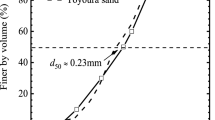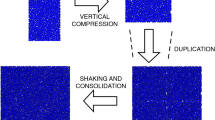Abstract
The actual drainage conditions in situ will be neither perfectly drained or undrained but will be partially drained. In the meantime, granular material behavior is sensitive to the intermediate principal stress ratio b = (σ2−σ3)/(σ1−σ3). While the conventional triaxial behavior of granular material under partial drainage condition has been extensively investigated, true triaxial behavior of granular material under partial drainage condition has not been studied. In this study, a series of DEM simulations are conducted to investigate both the macro- and micro-scale behavior of sand, considering the combined effects of the partial drainage conditions and intermediate principal stress ratios (b = 0, 0.5, and 1.0). The initial fabric anisotropy is integrated into consideration, which is measured through a bedding plane angles α = 0°, 30°, 45°, 60°, and 90°. The second order work criterion is used to detect the occurrence of instability under different loading conditions. During the entire loading process, the internal structure evolutions of the granular assemblies are quantified through a contact-normal-based fabric tensor. The interplay between the external loading and the internal fabric evolution is analyzed in detail, which can provide useful insights into the macro-scale observations.

















Similar content being viewed by others
References
Sivathayalan, S., Logeswaran, P.: Behaviour of sands under generalized drainage boundary conditions. Can. Geotech. J. 44(2), 138–150 (2007)
Daouadji, A., Hicher, P.Y., Jrad, M., Sukumaran, B., Belouettar, S.: Experimental and numerical investigation of diffuse instability in granular materials using a microstructural model under various loading paths. Géotechnique 63(5), 368–381 (2013)
Chu, J., Wanatowski, D., Loke, W.L., Leong, W.K.: Pre-failure instability of sand under dilatancy rate-controlled conditions. Soils. Found. 55(2), 414–424 (2015)
Wu, Q.X., Xu, T.T., Yang, Z.X.: Diffuse instability of granular material under various drainage conditions: discrete element simulation and constitutive modeling. Acta. Geotech. 15, 17631778 (2020)
Wan, R., Nicot, F., Darve, F.: Failure in geomaterials: a contemporary treatise, 1st edn. ISTP Press—Elsevier, London (2017)
Sivathayalan, S., Logeswaran, P.: Experimental assessment of the response of sands under shear–volume coupled deformation. Can. Geotech. J. 45(9), 1310–1323 (2008)
Daouadji, A., Darve, F., Al Gali, H., Hicher, P.Y., Laouafa, F., Lignon, S., Wan, R.: Diffuse failure in geomaterials: experiments, theory, and modeling. Int. J. Numer. Anal. Meth. Geomech. 35(16), 1731–1773 (2011)
Daouadji, A., Jrad, M., Robin, G., Brara, A., Daya, E.M.: Phase transformation states of loose and dense granular materials under proportional strain loading. J. Eng. Mech. 143(1), C4016007 (2017)
Barreto, D., O’Sullivan, C.: The influence of inter-particle friction and intermediate stress ratio on soil response under generalized stress conditions. Granul. Matter. 14, 505521 (2012)
Abelev, A.V., Lade, P.V.: Effects of cross anisotropy on three-dimensional behavior of sand. I: stress-strain behavior and shear banding. J. Eng. Mech. 129(2), 160–166 (2003)
Lade, P.V., Abelev, A.V.: Effects of cross anisotropy on three-dimensional behavior of sand. II: Volume change behavior and failure. J. Eng. Mech. 129(2), 167–174 (2003)
Lade, P.V.: Failure criterion for cross-anisotropic soils. J. Geotech. Geoenviron. Eng. 134(1), 117–124 (2008)
Rodriguez, N.M., Lade, P.V.: True triaxial tests on cross-anisotropic deposits of fine Nevada sand. Int. J. Geomech. 13(6), 779–793 (2013)
Yoshimine, M., Ishihara, K., Vargas, W.: Effects of principal stress direction and intermediate principal stress on undrained shear behavior of sand. Soils. Found. 38(3), 179–188 (1998)
Uthayakumar, M., Vaid, Y.P.: Static liquefaction of sands under multiaxial loading. Can. Geotech. J. 35(2), 273–283 (1998)
Nakata, Y., Hyodo, M., Murata, H., Yasufuku, N.: Flow deformation of sands subjected to principal stress rotation. Soils. Found. 38(2), 115–128 (1998)
Li, X., Yu, H.S.: Influence of loading direction on the behavior of anisotropic granular materials. Int. J. Eng. Sci. 47(11–12), 1284–1296 (2009)
**e, Y.H., Yang, Z.X., Barreto, D., Jiang, M.D.: The influence of particle geometry and the intermediate stress ratio on the shear behavior of granular materials. Granul. Matter. 19(2), 35 (2017)
Jiang, M.D., Yang, Z.X., Barreto, D., **e, Y.H.: The influence of particle-size distribution on critical state behavior of spherical and non-spherical particle assemblies. Granul. Matter. 20(4), 80 (2018)
Lü, X.L., Qian, J.G., Huang, M.S.: Instability of sands under axisymmetric proportional strain and stress loadings. Eur. J. Environ. Civ. Eng. 23, 1–17 (2017)
Lashkari, A., Yaghtin, M.S.: Sand flow liquefaction instability under shear-volume coupled strain paths. Géotechnique 68(11), 1002–1024 (2018)
Jiang, M.J., Konrad, J.M., Leroueil, S.: An efficient technique for generating homogeneous specimens for DEM studies. Comput. Geotech. 30(7), 579–597 (2003)
Holtzman, R., Silin, D.B., Patzek, T.W.: Mechanical properties of granular materials: A variational approach to grain-scale simulations. Int. J. Numer. Anal. Meth. Geomech. 33(3), 391–404 (2009)
Belheine, N., Plassiard, J.P., Donzé, F.V., Darve, F., Seridi, A.: Numerical simulation of drained triaxial test using 3D discrete element modeling. Comput. Geotech. 36(1–2), 320–331 (2009)
Tong, Z.X., Fu, P., Dafalias, Y.F., Yao, Y.P.: Discrete element method analysis of non-coaxial flow under rotational shear. Int. J. Numer. Anal. Meth. Geomech. 38(14), 1519–1540 (2014)
Binesh, S.M., Eslami-Feizabad, E., Rahmani, R.: Discrete element modeling of drained triaxial test: flexible and rigid lateral boundaries. Int. J. Civil Eng. 16, 1463–1474 (2018)
Wu, Q.X., Yang, Z.X.: Novel undrained servomechanism in discrete-element modeling and its application in multidirectional cyclic shearing simulations. J. Eng. Mech. 147(3), 04020155 (2021)
Qu, T., Wang, M., Feng, Y.: Applicability of discrete element method with spherical and clumped particles for constitutive study of granular materials. J. Rock Mech. Geotech. Eng. 14(1), 240–251 (2022)
Wu, Q.X., Yang, Z.X.: Unified discrete-element approach applying arbitrary undrained loading paths in element testing for granular soils. Int. J. Numer. Anal. Meth. Geomech. 47, 3–22 (2023)
Li, X.S., Dafalias, Y.F.: Anisotropic critical state theory: role of fabric. J. Eng. Mech. 138(3), 263–275 (2012)
Zhao, C.F., Kruyt, N.P.: An evolution law for fabric anisotropy and its application in micromechanical modelling of granular materials. Int. J. Solids Struct. 196, 53–66 (2020)
Yang, Z.X., Xu, T.T., Chen, Y.N.: Unified modeling of the influence of consolidation conditions on monotonic soil response considering fabric evolution. J. Eng. Mech. 144(8), 04018073 (2018)
Wan, R.G., Guo, P.J.: Stress dilatancy and fabric dependencies on sand behavior. J. Eng. Mech. 130(6), 635–645 (2004)
Lashkari, A., Latifi, M.: A non-coaxial constitutive model for sand deformation under rotation of principal stress axes. Int. J. Numer. Anal. Methods 32(9), 1051–1086 (2008)
Fang, H., Shen, Y., Zhao, Y.: Multishear bounding surface modelling of anisotropic sands accounting for fabric and its evolution. Comput. Geotech. 110, 57–70 (2019)
Yang, Z.X., Liao, D., Xu, T.T.: A hypoplastic model for granular soils incorporating anisotropic critical state theory. Int. J. Numer. Anal. Meth. Geomech. 44(6), 723–748 (2020)
Tian, Y., Yao, Y.P.: Constitutive modeling of principal stress rotation by considering inherent and induced anisotropy of soils. Acta Geotech. 13(6), 1299–1311 (2018)
Wang, R., Cao, W., Xue, L., Zhang, J.M.: An anisotropic plasticity model incorporating fabric evolution for monotonic and cyclic behavior of sand. Acta Geotech. 16, 43–65 (2021)
Pan, K., Xu, T.T., Liao, D., Yang, Z.X.: Failure mechanisms of sand under asymmetrical cyclic loading conditions: experimental observation and constitutive modelling. Géotechnique 72(2), 162–175 (2022)
Liao, D., Yang, Z.X.: Hypoplastic modeling of anisotropic sand behavior accounting for rotation of principal stress direction. J. Eng. Mech. 148(10), 04022060 (2022)
Itasca Consulting Group, Inc.: PFC manual, version 5.0. Minneapolis (2015)
Cundall, P.A., Strack, O.D.: A discrete numerical model for granular assemblies. Géotechnique 29(1), 47–65 (1979)
Polakowski, C., Sochan, A., Bieganowski, A., Ryzak, M., Foldenyi, R., Toth, J.: Influence of the sand particle shape on particle size distribution measured by laser diffraction method. Int. Agrophys. 28(2), 195–200 (2014)
Liu, J., Otsubo, M., Kawaguchi, Y., Kuwano, R.: Anisotropy in small-strain shear modulus of granular materials: Effects of particle properties and experimental conditions. Soils Found. 62(1), 101105 (2022)
Huang, X., Hanley, K.J., O’Sullivan, C., Kwok, C.Y., Wadee, M.A.: DEM analysis of the influence of the intermediate stress ratio on the critical-state behaviour of granular materials. Granul. Matter. 16, 641655 (2014)
Gu, X.Q., Zhang, J.C., Huang, X.: DEM analysis of monotonic and cyclic behaviors of sand based on critical state soil mechanics framework. Comput. Geotech. 128, 103787 (2020)
Yang, D.S.: Microscopic study of granular material behaviors under general stress paths. (Doctoral dissertation, University of Nottingham, UK) (2014)
Li, X., Yang, D., Yu, H.S.: Macro deformation and micro structure of 3D granular assemblies subjected to rotation of principal stress axes. Granul. Matter. 18, 1–20 (2016)
Li, X., Yu, H.S., Li, X.S.: A virtual experiment technique on the elementary behaviour of granular materials with discrete element method. Int. J. Numer. Anal. Meth. Geomech. 37(1), 75–96 (2013)
Nicot, F., Challamel, N., Lerbet, J., Prunier, F., Darve, F.: Some insights into structure instability and the second-order work criterion. Int. J. Solids Struct. 49(1), 132–142 (2012)
Liao, D., Yang, Z.X.: Non-coaxial hypoplastic model for sand with evolving fabric anisotropy including non-proportional loading. Int. J. Numer. Anal. Meth. Geomech. 45(16), 2433–2463 (2021)
Kanatani, K.I.: Distribution of directional data and fabric tensors. Int. J. Eng. Sci. 22(2), 149–164 (1984)
Yang, Z.X., Wu, Y.: Critical state for anisotropic granular materials: A discrete element perspective. Int. J. Geomech. 17(2), 04016054 (2017)
Acknowledgements
This research is supported by the Natural Science Foundation of China (Grant No. 52208366 and 52078236) and the Department of Science and Technology of Hubei Province (Grant No. 2023AFB578). The authors gratefully acknowledge the financial supports.
Funding
National Natural Science Foundation of China,52208366,Qixin Wu,52078236,Jun-Jie ZHENG,Department of Science and Technology,Hubei Provincial People's Government,2023AFB578,Qixin Wu
Author information
Authors and Affiliations
Corresponding authors
Ethics declarations
Conflict of interest
The authors declare that they have no known competing financial interests or personal relationships that could have appeared to influence the work reported in this paper.
Additional information
Publisher's Note
Springer Nature remains neutral with regard to jurisdictional claims in published maps and institutional affiliations.
Rights and permissions
Springer Nature or its licensor (e.g. a society or other partner) holds exclusive rights to this article under a publishing agreement with the author(s) or other rightsholder(s); author self-archiving of the accepted manuscript version of this article is solely governed by the terms of such publishing agreement and applicable law.
About this article
Cite this article
Faraji, S., Zheng, Jj. & Wu, Q. Macro- and micro-scale behavior of inherently anisotropic sands under true triaxial loading paths considering partial drainage conditions. Granular Matter 26, 30 (2024). https://doi.org/10.1007/s10035-024-01400-y
Received:
Accepted:
Published:
DOI: https://doi.org/10.1007/s10035-024-01400-y




